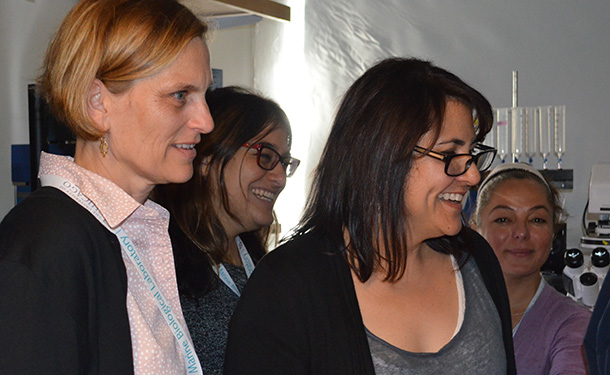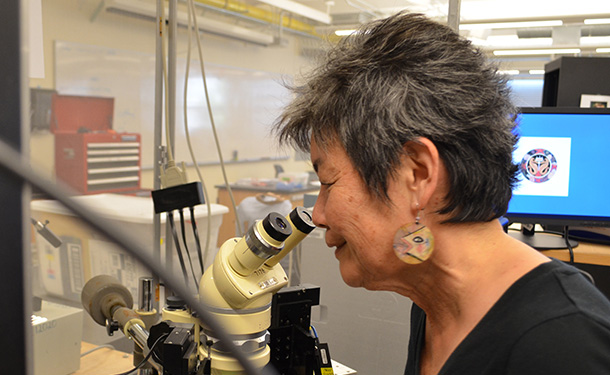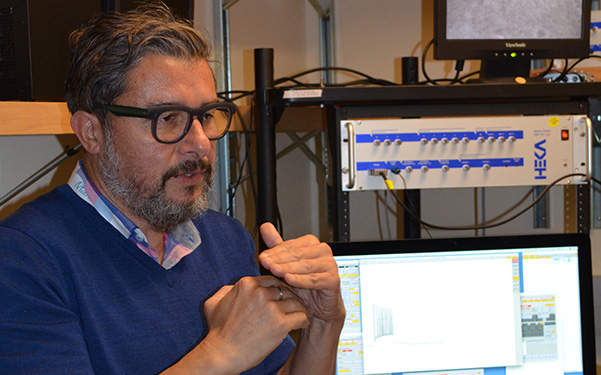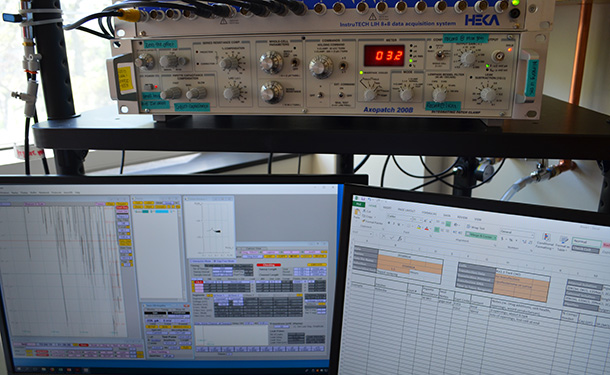Querying the Brain with State-of-the-Art Technology: The MBL Neurobiology Course

Every summer at the Marine Biological Laboratory, the seaside campus is teeming with scientists from around the world, including more than 540 pre- and post-doctoral trainees from about 40 different countries. It’s like an exuberant, intensely exploratory United Nations of Science.
Since the MBL’s founding, it has fostered both breakthroughs in the life sciences and future scientific pioneers by closely coupling research and education. Each student gains valuable research experience with the help of state-of-the-art equipment and skilled, passionate faculty who are also leading investigators in their field.
 Neurobiology course co-directors Ellen Lumpkin of Columbia University Medical Center (left) and Diana Bautista of University of California, Berkeley. (The third course co-director is Marc Hammarlund, Yale University.) Behind them are teaching assistant Yalda Moayedi of Columbia University and student Zazil Villanueva-Esperon of University of Rhode Island. Credit: D. Kenney
Neurobiology course co-directors Ellen Lumpkin of Columbia University Medical Center (left) and Diana Bautista of University of California, Berkeley. (The third course co-director is Marc Hammarlund, Yale University.) Behind them are teaching assistant Yalda Moayedi of Columbia University and student Zazil Villanueva-Esperon of University of Rhode Island. Credit: D. KenneyThe Neurobiology course, one of MBL’s Advanced Research Training Courses, is representative of its science-in-action model of education. The average student may start off their day with a lecture from a preeminent scientist in the field — maybe even a Nobel Laureate. This year, Neurobiology students heard from Rod Mackinnon of Rockefeller University, who won the Nobel Prize in 2003 for determining the structure of ion channels and who has lectured in the course since 2000.
After their morning lectures, students are immersed in a hands-on lab that stretches late into the evening hours. During the last section of the course, called Integrative Neurobiology, small teams of students form their own hypotheses about the nervous system, and with the help of the faculty, design experiments to answer these questions using techniques learned in the three prior units: Genomics, Electrophysiology, and Imaging. They then present their findings to the other students and the directors.
“This course teaches students how to use a breadth of technologies and approaches to answer fundamental scientific questions,” says Diana Bautista, Neurobiology course co-director from the University of California, Berkeley. “It emphasizes how to use different technology to answer the same biological question, and also how to use the same technology to answer different questions.”
Learning How to Teach
MBL course faculty disseminate a vast amount of knowledge in a short period of time. While teaching, they are simultaneously exploring new technologies and scientific questions themselves. Neurobiology course directors, faculty, teaching assistants, and students have even published peer-reviewed papers based on their work in the course.
“The students learn an enormous amount about how to be a neuroscientist,” says course co-director Ellen Lumpkin of Columbia University Medical Center. “But the course is also training the next generation of neuroscience educators. We have students who go on to be teaching assistants; teaching assistants who go on to become faculty.”
 MBL Education Director Rae Nishi visits the Neural Systems & Behavior (NS & B) course. While the Neurobiology course focuses on cellular neuroscience, NS & B explores correlations between nervous system activity and behavior in several organisms. Credit: D. Kenney
MBL Education Director Rae Nishi visits the Neural Systems & Behavior (NS & B) course. While the Neurobiology course focuses on cellular neuroscience, NS & B explores correlations between nervous system activity and behavior in several organisms. Credit: D. Kenney“I actually took Neurobiology back in 1977,” says MBL’s Director of Education, Rae Nishi. “I eventually came back to teach the course when I was a postdoctoral fellow, and later I became a course director. Today, Neurobiology is a great example of how these courses are using impressive, state-of-the-art technology.”
“Super State-of-the-Art”
During the second course unit, Electrophysiology, students work with customized “rigs” that Nishi calls “super state-of-the-art.” Rigs are microscopes hooked up to electronic equipment, such as amplifiers and micromanipulators, that allow students to observe nervous processes in different organisms at the molecular, cellular, and tissue levels. These specialized rigs are made possible by the generosity of scientific equipment vendors, who loan state-of-the art equipment to MBL courses throughout the summer.
The Neurobiology students learn to operate six different rigs and interpret their signals in just under two weeks. “Our goal, by the end of each day, is that every student has had a successful recording from a rig,” says Lumpkin.
Prior to Electrophysiology, students begin with a Genomics Bootcamp. In this unit, they sequence and compare vast RNA and DNA data sets for three model organisms: zebrafish, mice, and fruit flies. In all three, they compare normal sets of DNA, called wild type, to mutant sets, in which they had altered the genes responsible for communication between epithelial cells, such as those inside the small intestine. Understanding this kind of cell-to-cell communication can illuminate treatments for Crohn’s and other inflammatory diseases.
After the Electrophysiology unit, students move on to Imaging, where they learn the basics of optics and how light interacts with different materials and molecules. Each student learns to construct and use the most advanced microscopy technology for fluorescence lifetime imaging, multi-photon, and light-sheet microscopy.
 Ricardo Araneda of University of Maryland, faculty leader for the Electrophysiology section, leads a training session. Credit: D. Kenney
Ricardo Araneda of University of Maryland, faculty leader for the Electrophysiology section, leads a training session. Credit: D. Kenney“The most valuable takeaway from the course, for me, is how directly applicable the techniques and information are to my own research,” says Raul Ramos, a PhD student at Brandeis University. “I’m excited to translate what I learned into my lab at Brandeis, where I’m studying the role of homeostatic plasticity in learning.”
Neurobiology and MBL’s other Advanced Research Training Courses are opportunities for both students and faculty to learn and practice the most up-to-date research technologies, all of which will come in handy in their careers moving forward. And who knows — maybe the future will lead them to a Nobel Prize-worthy discovery, or back to the MBL to teach the next generation of pioneers.
Home page photo caption:
Neurobiology students learning single-channel recording on an electrophysiology rig brought by Jon Sack from University of California, Davis. At right is teaching assistant Rebecka Supela from Sack’s lab; sitting is student Briana Pinales from University of Texas, El Paso; standing is student Robin Grob from Wuerzburg University, Germany. Credit: D. Kenney.
—###—
The Marine Biological Laboratory (MBL) is dedicated to scientific discovery – exploring fundamental biology, understanding marine biodiversity and the environment, and informing the human condition through research and education. Founded in Woods Hole, Massachusetts in 1888, the MBL is a private, nonprofit institution and an affiliate of the University of Chicago.
What’s it Like to Take the Neurobiology Course?
Two students from the 2018 class share their experience:
Raul Ramos, PhD candidate, Brandeis University:
“One major benefit of taking the course is getting to meet researchers from all over the world. The diversity makes it an inspiring and engaging learning environment. Another benefit is we get hands-on mentorship from experts in the field who care and put a lot of time into mentoring us, oftentimes one-on-one.”
“The most challenging part of the course was trying to cover a daunting scope of information in a short amount of time, but as a group we adapted to the course. It helped that we didn’t have to focus on anything else and could just fully immerse ourselves.”
José Miguel Andrade-López, PhD candidate, Stanford University:
“I’ve gained technical knowledge in genetics, imaging, and electrophysiology for model systems that hasn’t been applied to non-model organisms. So it’s very exciting for me to take this knowledge and these techniques to my lab back home and apply them to the system I study, the neural development of the acorn worm.”
“What I really loved about the course was being surrounded by people from different research and cultural backgrounds. I’ll be able to collaborate with both the teachers and students even after I leave. I’ve built relationships with them and I know we’ll continue to share our knowledge into the future.”
